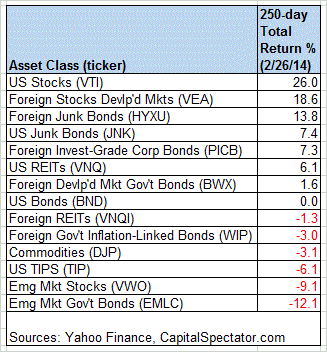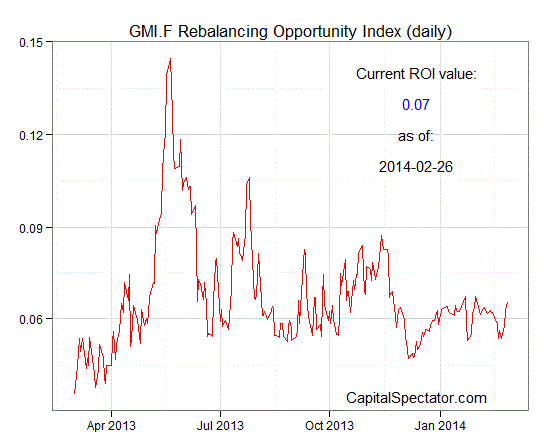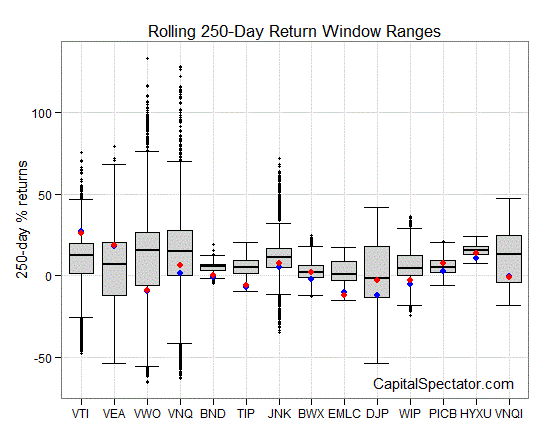Equities in developed markets and foreign junk bonds continue to hold the edge as the performance leaders, based on our standard set of ETF proxies via a 250-trading-day window (the rough equivalent of 1-year returns). Meanwhile, broadly defined measures of bonds and stocks in emerging markets are still bumping along at the bottom of the performance ledger for investable products that represent the major asset classes.
In other words, not much has changed since our previous update from several weeks ago. True, the returns for the leaders are moderately higher and the losses have eased a bit. Meantime, there’s nothing subtle about the relatively wide spread—38 percentage points– between the top performer (US stocks) and its counterpart at the opposite end of the performance spectrum (emerging markets government bonds).
Let’s turn to a graphical summary of how the numbers compare by reviewing the relative performance histories for each of the major asset classes for the past 250 trading days by way of the ETF proxies. The chart below shows the performance records through February 26, 2014, with all the ETFs rebased to 100 based on a start date of February 28, 2013:
Now let’s consider an ETF-based version of a passive, market-value-weighted mix of all the major asset classes–the Global Market Index Fund, or GMI.F, which is comprised of all the ETFs in the table above. Here’s how GMI.F stacks up for the past 250 trading days through February 26, 2014. This investable strategy is higher by around 12% across that time frame, or roughly midway between the returns for US stocks (VTI) and US bonds (BND) over the same period.
Comparing the overall dispersion of returns for the major asset classes via ETFs suggests that the rebalancing opportunity is still relatively middling for GMI.F overall vs. recent history. Analyzing the components of GMI.F with the rolling median absolute deviation of one-year returns for all the funds–the GMI.F Rebalancing Opportunity Index, as it’s labeled on these pages–suggests that there’s average potential generally for adding value by reweighting this portfolio in comparison with the past 12 months. Keep in mind that the potential for rebalancing will vary depending on the choice of holdings and historical time window. Meantime, don’t overlook the possibility that any given pair of ETFs may offer a substantially greater or lesser degree of rebalancing opportunity vs. analyzing GMI.F’s components collectively.
Finally, let’s compare the rolling 1-year returns (250-trading-day performance) for the ETFs in GMI.F via boxplots for a revealing comparison of price momentum across the board. The gray boxes in the chart below reflect the middle range of historical 250-day returns for each ETF—the 25th to 75th return percentiles. The red dots show the current return (as of February 26) vs. the 250-day return from 30 trading days earlier (blue dots, which may be hiding behind the red dots in some cases). Note that the red dots have been moving higher in recent weeks. Positive momentum, it seems, is in vogue again… at least for the moment. (Keep in mind that the historical records for these ETFs vary due to different launch dates.)





Pingback: Thursday links: value’s superiority | Abnormal Returns
Pingback: Just A Correction… Or Something Darker For U.S. Equities? | Prompto Capital